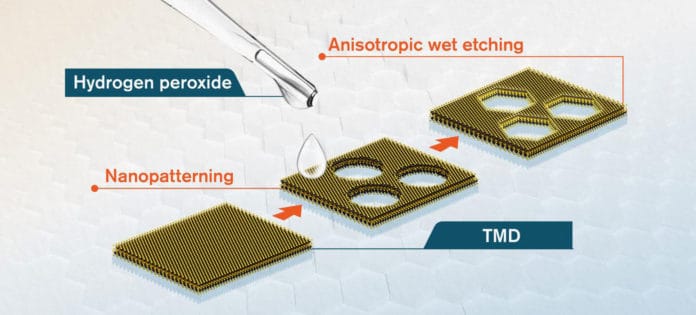Thanks to a new method developed by scientists at the Chalmers University of Technology, Sweden, now it is possible to control the edges of two-dimensional materials using a ‘magic’ chemical. The method controls the edges in both an easy and scalable way, using only mild heating and abundant, environmentally friendly chemicals, such as hydrogen peroxide.
Controlling the edges is a challenging scientific problem because they are very different from the main body of a 2D material. For example, a specific type of edge found in transition metal dichalcogenides (known as TMD) can have magnetic and catalytic properties.
The edges of TMD materials can exist in two different variants, known as zigzag or armchair. Calculations predict that zigzag edges are metallic and ferromagnetic, whereas armchair edges are semiconducting and non-magnetic. Like these remarkable variations in physical properties, one could expect that zigzag and armchair edges’ chemical properties are also very different. If so, it could be possible that certain chemicals might ‘dissolve’ armchair edges while leaving zigzag ones unaffected.
Now, scientists have found a magic chemical in the form of ordinary hydrogen peroxide.
Battulga Munkhbat said, “It was not only that one type of edge was dominant over the others, but also that the resulting edges were extremely sharp – nearly atomically sharp. This indicates that the ‘magic’ chemical operates in a so-called self-limiting manner, removing unwanted material atom-by-atom, eventually resulting in edges at the atomically sharp limit. The resulting patterns followed the crystallographic orientation of the original TMD material, producing beautiful, atomically sharp hexagonal nanostructures.”
This new method includes a combination of standard top-down lithographic methods with a new anisotropic wet etching process, therefore makes it possible to create perfect edges in two-dimensional materials.
Timur Shegai, Associate Professor at the Department of Physics at Chalmers and leader of the research project, said, “This method opens up new and unprecedented possibilities for van der Waals materials (layered 2D materials). We can now combine edge physics with 2D physics in one single material. It is a fascinating development.”
Journal Reference:
- Munkhbat, B., Yankovich, A.B., Baranov, D.G. et al. Transition metal dichalcogenide metamaterials with atomic precision. Nat Commun 11, 4604 (2020). DOI: 10.1038/s41467-020-18428-2
